Executive Summary:
This academic business report presents a detailed analysis of the change leadership and strategic management of the Qatargas Company of Qatar. Qatargas is the leading Gas Company of Qatar and the third-largest exporter of LNG in the world. Presently, Qatargas clientele is extended all over the four corners of the world in Europe, Asia, and America. The Qatargas Company is recognized for its operating excellence, innovation, environmental responsibility, people, and corporate citizenship.
The report further presents Strategic Business Framework along with its external and internal analysis. The report further analyzes the leading implementation of the company with its stakeholder analysis, results-based leadership, and ladder analysis.
Lastly, the report presents the recommendations and conclusion of how Qatargas could improve its current position and could meet its future challenges.
Introduction:
There are several types of leadership but the customary model, which is upside down known as transformational leadership. In this type of leadership, the leader is not being obligated to convey orders to their subordinates but he t leader gives guidelines and further provides complete and obliging vision according to its own mental state. Moreover, the leader develops passion and positivity to adopt that mind state, and hence leader is trustworthy and creates respect. (Jones, 2015)
Transformational leadership is also demarcated as an approach that grounds change in social systems and individuals. This form of leadership generates valued and plausible transformation in the admirers with the ultimate goal of transforming admirers into leaders. Transformational leadership in its endorsed form increases the morale, performance, and motivation of admirers through different methods. These methods include be a character model for the admirers that encourages them; challenging the admirers to undertake ownership of their every work; making a connection between the sense of self and individuality of admirers with the mission and the overall individuality of the organization. This leadership also includes the method to understand the weaknesses and strengths of the admirers, this mechanism will enable leaders to create alignment of admirers with their tasks. (Bass & Avolio, 1994)
In the present globalization and digitalization era, organizations are bringing change in their leadership style from a conventional, top-down, compliance-based transactional set of behaviors and practices to ones focused on leadership interaction and commitment, influence, inspiration, collaboration, and communication. This is considered revolutionary and is also known as a paradigm shift. (Gilbert, 2012)
One such paradigm shift could be seen in the oil and gas industry of Qatar. It took merely less than three decades for the country, Qatar to change itself from a small oil producer to a well-placed, trustworthy, and devoted global trader of energy. At present, Qatar is the world’s leading LNG producer having a production capacity of 77 million tonnes per annum (MTA), along with proving to be the market leader in the gas industry. In achieving this transformation for Qatar, Qatargas Company has played an important role. (Avril & Walker, 2014)
The kind of transformational leadership discussed above could be seen in the Qatargas Company of Qatar. Besides, when we focus on leading strategic change, the first thing we need to understand is the business strategy framework. Hence, the section will present the business strategy framework of Qatargas.
Qatar Gas Business Strategy Framework
Introduction and Development:
Qatargas has become the leading LNG producer internationally, with an annual LNG production capacity of 42 million tonnes per annum. Over the years Qatargas has developed to a greater extent than today it leads the liquefied natural gas (LNG) industry of Qatar. The company has a vision of delivering LNG to customers around the world with the help of its superlative facilities in Qatar. From the huge North Field of Qatar, Natural gas is delivered to Qatargas’s LNG trains that are undoubtedly today considered as the largest gas field in the world (Carlisle, 2010).
Qatargas was established in 1984 with its headquarters in Doha, Qatar. The Qatargas offshore operations are situated around 80 kilometers northeast of the mainland of Qatar, while the company upholds its upstream resources in Ras Laffan, Qatar.
Initially, the company was created to function three LNG trains with an intended two million tonnes capacity each annually. This was named Qatargas 1. The shareholders of Qatargas 1 are renowned national and international companies including Qatar Petroleum, Total, Marubeni ExxonMobil, and Mitsui. Qatargas 1 possesses three LNG trains. It produced 10.09 million tonnes of liquefied natural gas (LNG) in 2008 (Karrar, 2009) which reached an estimated production of 42 million tonnes per annum (mtpa) by the end of 2012 (Oxford Business Group, 2014).
Due to its effective strategic management and leadership, Japan becomes the first importer of the LNG of Qatargas through the company’s first shipment delivery in 1996 to Japan. In 2005, the company associated unit with the name of Qatargas Operating Company Limited was formed to operate and sustain the resources of Laffan Refinery, Qatargas 1, Qatargas 2, Qatargas 3, Qatargas 4, and other resources in support of the shareholders. (ADAMS & BILLS, 2008).

Officially, the Qatargas 2 project was launched on 6 April 2009. Qatargas II was a joint venture of ExxonMobil and Qatar Petroleum and possesses LNG trains 4 and 5 with each having a capacity of 7.8 million tonnes per annum (mtpa). It is providing LNG for the South Hook LNG terminal at Milford Haven, Pembrokeshire, Wales, from where gas is passed to the South Wales Gas Pipeline. This pipeline fulfills the United Kingdom’s 20% needs for LNG. (Davis, 2009)
Followed was the production of Qatargas 3 in November 2010 which was a joint venture between Mitsui, ConocoPhillips, and Qatar Petroleum; while Qatargas IV was formed in January 2011 and was a joint venture between Qatar Petroleum and Royal Dutch Shell (shell, 2015). Initially, they operated as separate projects, but now Qatargas III and IV are being controlled by a mutual asset development team that is formed of the employees of Qatargas, Shell, and ConocoPhillips in addition to project directly employed and short term contractor. The trains of these projects were started to operate by the end of 2010 and early 2011. (Oxford Business Group, 2014)
These extension projects have added four new LNG trains with each train having a capacity of 7.8 mtpa. The two trains of Qatargas 2 supply its LNG to markets in the United States, United Kingdom, Europe, and Asia, while Qatargas 3 delivers its LNG primarily to Asia, Europe, and the United States, whereas Qatargas 4 mainly serve Asia, the Middle East, and North America (Carlisle, 2010)
The energy company Qatargas is not only the largest LNG producer but also it is also the largest condensate producer, which has the capability to refine more than 146,000 barrels per day. It has to include that its refinery capability will increase to 300,000 barrels per day with the establishment of the Laffan Refinery project in the middle of 2016. This project is strategically significant because this expansion project will diversify Qatar in its energy production and will attain a new market position as well.
Sustainability of Competitive Advantage of Qatargas:
Presently, Qatargas clientele is extended all over the four corners of the world in Europe, Asia, and America. The Qatargas Company is recognized for its operating excellence, innovation, environmental responsibility, people, and corporate citizenship. So far, the company has assisted commission 14 LNG getting terminals across Asia, Europe, and America. The largest list of accomplishments of Qatargas would not be conceivable without having the strongest safety and environmental standards that are interconnected with various cultures of its workforce as a basis of strength.
The Company’s vision, mission statement, and values reflect the leaders’ sustainability approach. The vision of Qatargas leaders is “
“To be known for our people, operating excellence, innovation, and corporate citizenship.”
While setting a high standard for:
- Customer satisfaction
- Financial performance
- A highly capable, diverse workforce
- Health, Safety and Environmental performance
- Reliable and Efficient operations
While achieving the vision with the use of its resources including, reserves, people, environment, and the facilities, the company strives to meet its mission of:
- Faultlessly executing projects and capturing synergies by efficiently integrating new projects into existing operations.
- Leveraging the expertise and knowledge of the workforce and shareholders.
- Maintaining the highest quality, health, safety, and environmental standards.
- Efficiently producing and delivering LNG and gas-derived products to customers around the globe.
- Maximizing value and creating opportunities for shareholders.
- Optimistically contributing to community development.
- Attracting, retaining, developing, and motivating a high-level, diverse workforce.
- Constantly improving governance, operating, and business performance.
In the course of achieving the mission and vision, Qatargas values its people and their families, its customers, shareholders, communities, suppliers, and the environment. For this, the company strictly incorporates the following initiatives:
- Conduct the business in an ethical manner and with integrity.
- Work in and encourage a will of dynamic shared support.
- Identify, acknowledge and reward accomplishments.
- Perform the highest standards of social and environmental practice.
- Using diversity as a source of strength.
- Sensibly communicate and distribute information.
- Developing people and fostering a culture of innovation, excellence, and learning.
- Provides an Injury and Incident-Free workplace.
- Empower and trust each other, promote the initiative, and assume responsibility.
External Analysis of QatarGas 2022
The entire LNG market of Qatar is dominated by only two giant companies including the Qatargas Operating Company Limited (Qatargas) that is operating four main LNG projects (Qatargas 1-4) and Ras Laffan Company Limited (RasGas) that is operating three main LNG projects (RasGas I-III). (Al-Emadi, 2012).
When we talk about LNG global Market, Qatar is ranked as the largest exporter of LNG in the world. More than 84% of Qatar’s total exports of gas are in the form of Liquefied Natural Gas (LNG) (Clough, 2013).
Assisted by growing demand globally accompanied by stiff supply, Qatar experiences its LNG exports growth from 25.3 cm in 2004 to more than 104.7 cm in 2013, representing over a third of global supply in the same year (Avril & Walker, 2014).
Qatar LNG exports when compared with its closest competitor that is Russia, the target markets show a difference as shown in the graphical representation below. In 2011, Qatar LNG exports by destination were targeting Asia 48% while Europe 42% whereas Russia’s natural gas exports reveal an entirely different scenario showing its minimum existence in the Asian Market.

By 2014, the export ratio changes drastically with Asia leading 75% of the total LNG export of Qatar while shirking the exports to Europe to 23% with just 2% to North America (Mantena, 2014) as shown in the graphs below:
Qatar exports in 2014
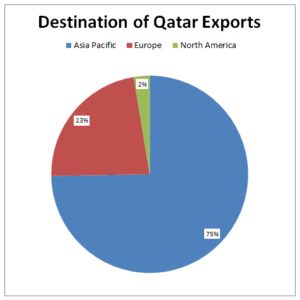
Amongst the importers of Qatar Gas, Japan was the first and the largest market since then, afterward South Korea, India, and China takes the lead. These four countries collectively comprise 62 % of Qatar’s total exports of LNG (Zawya, 2014).
Factors like high LNG prices in Asia, cheaper pipeline gas supplies, weak economic growth, and a gentle winter in Europe lead to a decline in European LNG imports by Qatar in 2013. In Europe, The United Kingdom is the major market for Qatar’s LNG exports (36.8%), subsequently Italy (23.6 %) and Spain (14.3%) revealing the fact that over time, the Asian Market has proved to be a great growth potential market for the Qatar LNG companies. (IGU, 2014)
Context Analysis: Threats for Qatargas
According to statistics calculated by International Gas Union (IGU), the global capacity of LNG plants can be increased from 396 cm per year to 555 cm per year due to the installation of new LNG plants around the world. Most of the gas was extracted from the Middle East in 2013 (about 42% of world consumption) with 79% of this percentage extracted from Qatar. shortly, this situation seems to change drastically because:
- Australia is going to contribute in current capacity by 84 bcm/y by end of 2020 and it will replace Qatar as the biggest source of gas, and what is discussed by The Economist is “The Next Qatar”.
- By the year 2020, the United States of America can also turn out to be a huge exporter of gas. According to estimates of HIS, United States can contribute to current capacity by 68 bcm/y by the end of this decade. If these estimates come true, United States will become the third-largest exporter of gas by the end of this decade after Qatar and Australia.
- East Africa and Canada are also seen as potential exporters of gas.
- Currently, Qatar is a major exporter of gas in Europe. Russia can compete with Qatar in Europe through Yamal LNG Project by Novatek. Russia plans to grow its exporting capacity to 68bcm/y as it competes with Qatar in the Asia Pacific region. Russia will be able to develop this liquefaction capacity by 2020 (Isanti, 2013).
- Iran can turn out to be a competitor of Qatar in the region of South Asia and the Middle East, especially in Pakistan and India depending upon the geopolitical situation of the region in Iran.
According to calculations of Bank of America, if the gas is produced and exported at such a large scale, the supply of gas will surpass the demand by 10% in 2020. ‘Multiyear bear market’ can be the result of this state. The long-term plans of British Petroleum (BP) suggest that BP will increase the capacity to 508bcm/year by 2035. In the same period, the United States and Australia will be providing one-third of the requirements of gas to the world. The market share of Qatar may drop to about 12% by 2035 as a result of an increase in the contribution of BP, the United States, and Australia. The expected largest share will be acquired by Australia with 24%, then Africa with 21%, and finally the United States with 18% of the total market share. (Mantena, 2014)
Future Challenges for Qatargas
Due to such a projected increase in supply, the gas industry in Qatar may have to face several challenges.
- The first major challenge is the entry of major suppliers into the market.
- Second, the expansion of the United States and Iran may limit the capacity of Qatar in the market of condensate and liquefied petroleum gas.
- Third, an increase in the supply of gas more than demand will result in pressure on prices to decrease.
- Finally, a lot of suppliers in the Asian market will provide Asian buyers with more negotiating power to put pressure on suppliers to further decrease the price.
Qatar bases its long-term contracts on oil prices rather but if the price of gas becomes too low, this base will be challenged internationally. Qatar’s largest source of revenue will be facing fierce market competition in that case.
As the contextual analysis and strategic vision are both long and peripheral into the leadership practice; let us now review QatarGas’ leadership initiatives and see how the company copes with the existing and future challenges.
Strategic Implementation: Leadership at Qatargas
“As a leader in the global energy industry, Qatargas has made significant contributions to a sustainable future for our country and the world at large.”
– Qatargas CEO, Khalid Bin Khalifa Al Thani.
Throughout its 30 years, Qatargas has been pioneering, driven by the vision of its best leaders H.H. the Emir, Sheikh Tamim Bin Hamad Al Thani, and H.H. the Father Emir, Sheikh Hamad Bin Khalifa Al Thani, and has become a major and influential player in the global oil and gas sector.
Stakeholders and Leadership at Qatargas
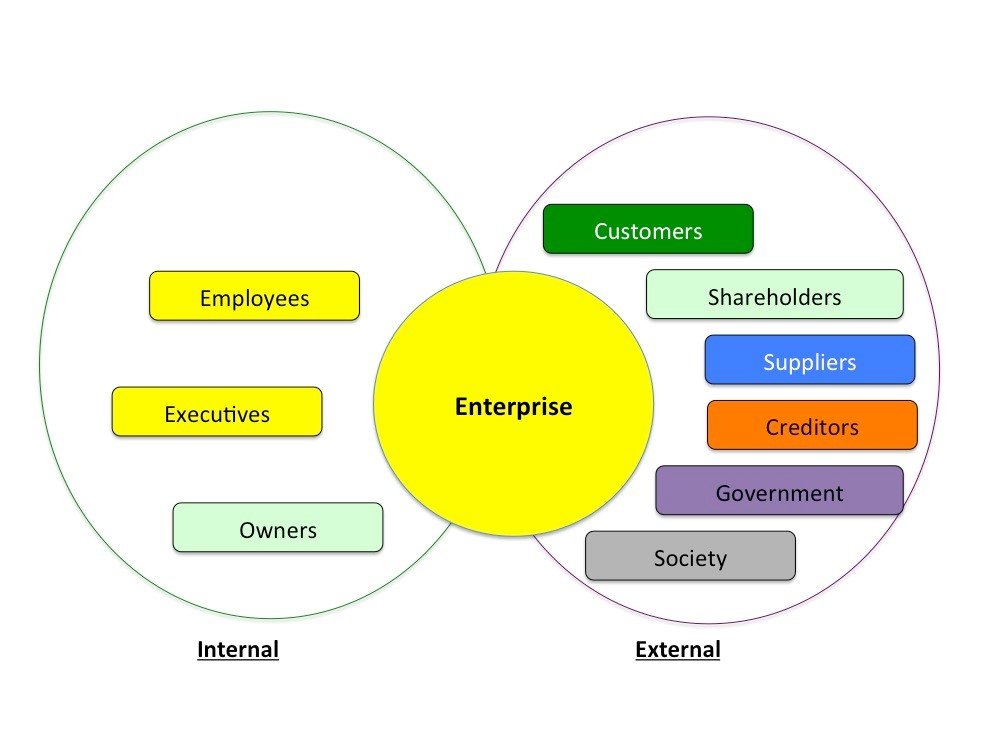
The diagram above shows the internal and external stakeholders of a company
Stakeholders play a vital role in the life of a leader and the key goal of effective leaders is to find how they can create and add value to all of their stakeholders’ needs. If the leaders have this thing clear in their mind, they can plot these needs next to their existing strengths, discovering shortcomings and formulating plans to improve their personal competencies that deliver on stakeholders’ needs. (Smallwood, et al., 2007).
Hence keeping its stakeholders under consideration, Qatargas sets high standards for safety performance, customer satisfaction, efficient and reliable operations, financial performance, and successful and sustainable development.
Suppliers:
The company continues to build on its strong partnerships with the world’s premier energy companies, all of the leaders in the global LNG industry; to deliver to the world’s premier LNG customers, and it continues to attract the best employees from the global LNG community.
Employees:
The company protects its employees and other workers by implementing efficient practices, which shows that in the company safety of employees and workers is above all everything. This further proves the fact that the growth and development of the company have been achieved by complying best safety standards for the employees and workers in their operations. The company’s management is with the intention that every employee of the company should be unharmed and reached back home safely after completing the projects. Moreover, the culture of the company shows that there is efficient horizontal and vertical communication on all hierarchy levels.
Environment:
A campaign on climate change was developed by Qatargas in 2014 which was named as “Go Green Environment Awareness Campaign”. The issues of waste reduction, water conservation, and core principles of energy were discussed in the campaign. The primary objective was to mitigate the impact of the environmental change. They can be achieved through efficient use of water, switching off the electrical appliances when not in use, promoting recycling, and reuse \can solve the climate issues by a great deal.
The CEO of Qatargas once in a meeting hall states:
“Make a selection of best people and ensure that selection pattern will be good. Best people do mean that they have abilities like Einstein, but they must be educated and experienced and have the willingness to do teamwork. Moreover, these people will need clarity from the company so it must hire good people, and resources for the hiring process is not enough. Therefore, the company needs to direct them accurately and the manager needs to be committed. The manager cannot show his commitment merely by words but it has to show practically. If a manager as a leader expects hard work from employees then he has to expect first from himself. A leader should show their employees that he is committed and wants the same commitment towards work from them as well. A good leader should have a good listening ability. A leader should not assume for himself that he has control so he knows everything. A leader should give every hired person an opportunity to listen.”
Safety Management Model of QatarGas
Abnormal safety events usually happen when workers consider doing the respective work in different ways, which create adverse results. Workplace vulnerability could be exposed to a gullible individual or a worker can either deliberately or instinctively interrelate with the work environment detrimentally. Hence, in the organization modern and sophisticated safety measures have been developed to vanish or even reduce the worker/environment crossing point through several different processes.

The modern safety management model can be further described with the help of the interaction of the following three main components:
- People: who may be at risk or may create risk for others. Hence, this model should concentrate on the usage of resources according to skills and competency. This model will involve certain programs, which will be observation, verification, utilization, education, and assessment. The purposes of these programs include giving awareness to people about associated risks and how to reduce them. Leaders have to face challenges in this process, which are understanding and managing the connection between individuals, teams, and supervisors. This safety model may not be affected well in the international work environment because of the diversification of cultures.
- Management Systems: These systems are formal practices that summarize the concerns and responsibilities and hence, entail the responsibility to certify that programs are executed effectively and constant development is taking place.
- Work Environment: It is the place where employees of the organization work and are exposed to risks. Leaders should consider the geography of the workplace and the kinds of environmental conditions that might exist and the different vulnerabilities in the work environment. The company should assess these hazardous conditions and implement cost-effective controls to reduce the exposures but this could not be only an option.
Many challenges are faced by Qatargas during the building of the largest LNG trains. These trains are going to be launched into a tough market that contains a mixture of inexperienced as well as experienced workers. Qatargas had to maintain an environment to undertake this challenge and sustaining a workforce that can outperform the dynamic conditions. Qatargas believes that a conducive environment is necessary for high performance. One of the ways to achieve the appropriate climate is through the leadership skills of the organization as mentioned in the Figure below. Qatargas has successfully achieved a no-blame environment where the safety management approaches are applied, employees are motivated and indicators of success are assessed. The most emphasized core value of Qatargas is safety.

Results-based Leadership
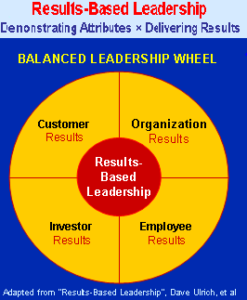
According to Results-based leadership, leaders not just demonstrate leadership attributes (like inspiring, influencing, etc,), competencies, and character but also focuses on achieving results. It incorporates how leadership competencies and organizational capabilities lead to and are linked to desired results. Hence, the equation for effective leadership is:
Effective Leadership = Attributes × Results.
Results-based leadership helps organizational performance measurement simpler. Calibration of leadership would have become very complex if there is no focus on results. Evaluating results supports organizations in several ways, from tracking leaders’ individual growth, to comparing leadership effectiveness in related roles, to clarifying the leader selection process, to structuring leadership development programs, to using results as the standard filters that should enter an organization and how they should be trained.”
Based on the results-based leadership, the next segment will review the results achieved by the leaders of Qatargas in strategic management and change management to measure the performance of the company’s leaders.
Qatargas Results-based Leadership
The company along with the compliance with environmental standards has provided different valuable projects that demonstrate the great technicality level and excellence with operations. The company has won two respected awards from the British Safety Council (BSC) named, ‘The Globe of Honor’ and ‘The Sword of Honor’ and now considered as the first energy company of Qatar to get these awards. The below pictures shows the results achieved by Qatargas as compared to the industry and the targeted performance standards:

Source: Qatargas Sustainability Pioneer Report 2015.
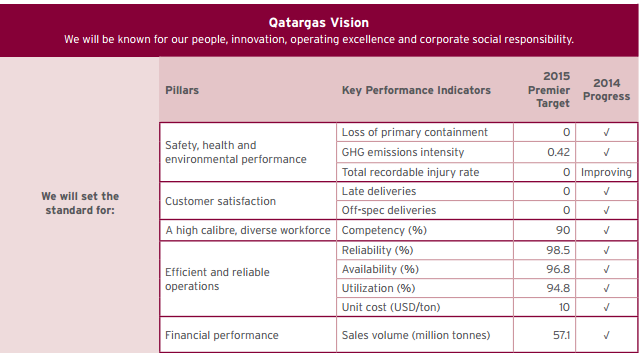
Holistic Behavioral Model:
A disciplined approach has been utilized by Qatargas to address the area of safety management that targets the workgroups and leadership of the organization. The priorities of the company are highlighted in the Ladder Model presented below. The major drivers are the management processes. A particular dimension of the workforce is addressed by the management system with complementary but uniquely aligned outcomes.
The workgroups are the target audience with the intent to utilize subtle peer pressure and modify their behavior. Reporting of good or bad behaviors is not enough for the workgroups. To effectively implement change, the management must support workgroups through their positive feedback and maintain a credible relationship with them. During this process, the reasons for the existence of unsafe conditions or acts are identified, recognize the conditions and acts that are achieved through positive behavior, and encourage those that are intended to be continued. The management is involved with the workforce in this effort which is driven by the use of data and it helps in achievement of the injury-free environments for the workgroups.
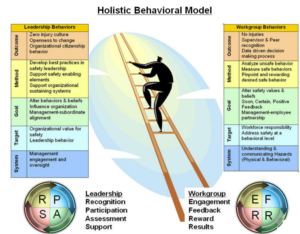
Positive Reinforcement (P+) Behavior Model concepts (Garlapati, et al., 2013)
A management system has been implemented that addressed the behavior of the workgroup which is represented on the right-hand side. Several functions performed by the management system include providing proof for results, rewarding desired behaviors, providing timely feedback, and engaging the workforce. Enhanced BBS program is one of the key implications of this management system which is associated with the workforce. It is modified with any changes of hazards or risks through time. The objective of the BBS program is to communicate information to the workgroups through a feedback system. The information is regarding the encouragement of the desired behaviors and the providing workgroups with the opportunities to work on the deficient areas.
Leadership management programs are on the left-hand side of the Ladder that seeks full participation from leadership ensures that the assessment of the program is carried out appropriately and helps in developing a company that encourages the efforts of safety management. Self-perception is compared with the actual perception to validate the results of the assessment. It helps in developing the understanding regarding changes that leadership needs to make to influence the organization regarding safety issues. A support mechanism requires this effort that ensures that the traditional safety management programs are carried out effectively. If the executive management or leadership is not interested, all the burden of safety management lies on the shoulders of the frontline workers who are willing to carry out the processes that are other than the tasks available immediately at hand.
Potential Future Leaders at Qatargas
A three-day residential program was attended by the students of Al-Khor International School. This program was the part of Cadre Leadership Development Program. The highest potential leaders of the Qatargas were targeted in this program. The co-educational and denominational international schools catered to the study needs of the RasGas and Qatargas. It offered the CBSE curriculum of India and the National Curriculum of England. (QatarGas, 2015)
Qatar National Vision (2030) is as follows: Qatar will adopt,
“…a proactive and significant regional role in assessing the impact of the climate change and mitigating its negative impact.”
Recommendation for Qatargas Management
This report concludes that Qatargas could be seen as a major player in the global market in the coming future. However, the Developments of Qatargas in the international market play a major role in altering the dynamics of international markets. These dynamics include the introduction of technology in exploration, drilling, and extracting the gas. Hence, Qatar Gas needs to overcome its challenges that are expected to be faced in the future and should focus on innovation and technology development to remain ahead of its competitors.
Conclusion
It is difficult to implement the programs in the long term without developing the right mechanism to sustain these programs. Engagement of the management as well as leadership is necessary; however, it may still be very difficult to reach the next level. Rules-based SMS does no longer exist. A safer workplace is the necessity of every employee today and the injuries are minimized through management of the case. To achieve high-class safety performance, Qatargas believes that the organization should gain control through engagement, making the workforce aware and understand the organizational objectives, ensuring that the positive behaviors are rewarded and broadcasted and proper implementation of the rules and regulations.
Bibliography
ADAMS, E. & BILLS, G., 2008. HIGH INTEGRITY PROTECTIVE SYSTEMS-CONCLUSION: QatarGas’ plant reflects typical HIPS applications. Oil and Gas Journal.
Al-Emadi, T., 2012. The Qatari Experience With Gas Joint Venture Contracts. National and International Issues in Natural Gas Development.
Anon., n.d. s.l.: s.n.
api.org, 2015. Liquefied Natural Gas EXPORTS – America’s Opportunity and Advantage, s.l.: American Petroleum Institute.
Avril, K. & Walker, J., 2014. Qatar: From strategy to implementation. Oil and Gas Financial Journal, 20 November.
Bass, B. M. & Avolio, B. J., 1994. Improving Organizational Effectiveness through Transformational Leadership. s.l.: Sage Publication.
Carlisle, T., 2010. Route 77 leads to a milestone in Qatar’s gas exports. The National Business, 14 December.
Clough, L. D., 2013. Energy profile of Qatar. The encyclopedia of Earth, 11 May.
Davis, J., 2009. Qatargas LNG output ‘hits record’. The upstream: the international gas and oil newspaper, 9 January.
Garlapati, A., Siddiqui, D. N. & Al-Shatti, D. F., 2013. Behavioral study of diverse workforce towards various Health, safety & environment engagement strategies in upstream. International Journal of Advancements in Research & Technology, 2(5).
Gilbert, K., 2012. Transformational Leadership. USA: xulon press.
I, 2014. World LNG Report, s.l.: International Gas Unit.
Isanti, T., 2013. Natural gas market – Qatar vs. Russia. Bq Doha, 5 November.
Jones, K., 2015. Transformational Leadership: Paradigm Shift or Incremental Change?. BSTsolutions, 25 February.
Karrar, T., 2009. Qatargas Inaugurates Trains 4 and 5. Dow Jones Newswires, 6 April.
Kauppi, A. et al., 2012. Transformational leadership, SA: creativecommons.org.
Mantena, D., 2014. BP World Energy 2014 Analysis Part 2: The Global Liquefied Natural Gas Market. BP Statistical review of world energy 2014.
Nijoka, D. & Mellen, F., 2013. Evolving market dynamics of global LNG. Oil and Gas Financial Journal, 1 May.
Oxford Business Group, 2014. The Report: Qatar 2014, s.l.: Oxford Business Group.
Qatargas, 2015. Change the future, change the world, Qatar: Qatargas.
shell, 2015. PetroSaudi – Venezuelan Oil Exploration and PetroSaudi International. Shell Me, 23 February.
Smallwood, N., Sweetman, K. & Ulrich, D., 2007. A Leader’s Five Key Stakeholders. Harvard Business Review, NOVEMBER.
Yukl, G., 1999. An evaluation of conceptual weaknesses in transformational and charismatic leadership theories… Leadership Quarterly, pp. 285-305.
Zawya, 2014. Qatar’s share of the LNG market slips. HSBC global connections, 19 August.

